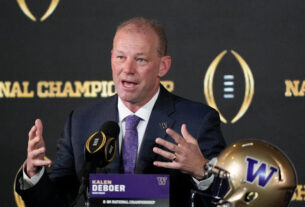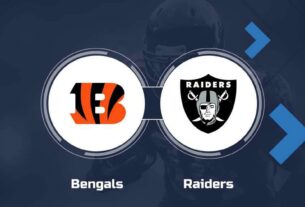Bengals Acquire RB Khalil Herbert from Bears for 2025 Draft Capital
In a stunning move on the eve of the 2024 NFL trade deadline, the Cincinnati Bengals have bolstered their backfield with the acquisition of running back Khalil Herbert from the Chicago Bears. The Bengals are sending an undisclosed package of 2025 draft picks to the Bears in exchange for the third-year running back, a move that signals Cincinnati’s commitment to improving their offense as they make a push for the postseason.
The deal is not only a critical one for the Bengals but also serves as a potentially pivotal moment for both teams involved as they navigate different phases of their respective seasons. The Bengals, perennial playoff contenders with a talented core led by quarterback Joe Burrow, are looking to add depth and explosiveness to a running game that has struggled to live up to its potential this season. Meanwhile, the Bears, who are currently in a rebuilding phase under head coach Matt Eberflus, have opted to trade away a valuable piece of their offense in order to acquire more future assets, continuing their long-term vision.
The Bengals’ decision to trade for Herbert comes as part of a larger strategy to improve their offensive balance and complement the dynamic passing attack spearheaded by Burrow. The Bengals have struggled with consistency in the running game, particularly since star running back Joe Mixon’s play has been erratic over the past few seasons. Mixon, once one of the most explosive running backs in the league, has faced a mix of injury issues, declining production, and an inability to produce consistently on the ground this year. Cincinnati has lacked a reliable change-of-pace back that can take the pressure off Burrow, and Herbert fits the bill.
Herbert, a 5’9”, 212-pound back out of Kansas, has been a promising part of the Bears’ offense since being drafted in 2021. His blend of speed, power, and vision has allowed him to excel in both between-the-tackles and outside-zone running schemes, making him an ideal fit for the Bengals’ system. Although Herbert was used primarily as a backup to David Montgomery in his first two seasons, he has steadily increased his role in the Bears’ offense, showing flashes of his potential in 2023 and 2024.
Through the first half of the 2024 season, Herbert has racked up 485 yards on 112 carries, averaging 4.3 yards per carry with 3 touchdowns. His ability to break tackles and churn out tough yards will make him an asset in the Bengals’ offensive system, which often looks for running backs who can not only get to the second level but also make defenders miss in the open field. Herbert has also demonstrated proficiency in the passing game, recording 26 receptions for 189 yards in 2024, and his versatility as a dual-threat back gives head coach Zac Taylor added flexibility.
Herbert’s acquisition brings the Bengals a younger, cheaper option compared to Mixon, who has had a cap hit of $12 million this year, making him a prime candidate for future roster changes. Mixon’s inconsistent play this season — paired with his hefty contract — had led to speculation about his future in Cincinnati, and the addition of Herbert is likely an indicator that the Bengals may move on from their veteran back in 2025.
By acquiring Herbert, Cincinnati gains a younger back with significant upside who can contribute immediately. He’s also a player with a reasonable contract — Herbert is on a rookie deal through 2025, which gives the Bengals the flexibility to make him part of their long-term plans without a major financial burden. His combination of speed and power fits the Bengals’ outside zone running scheme, and his ability to contribute as a receiver out of the backfield adds another dimension to the offense.
On the flip side, the Bears’ decision to trade away Herbert speaks to their ongoing rebuild. While Herbert has shown promise in his first three seasons, the Bears are committed to developing their future and building around quarterback Justin Fields and a defense that’s in the early stages of retooling. General manager Ryan Poles has consistently emphasized the importance of acquiring draft capital, and the trade of Herbert reflects that commitment to building for the long term.
Chicago’s running back situation has been in flux since the beginning of the season. While Herbert had solidified his role as the team’s primary back, the Bears have struggled with overall offensive production, ranking near the bottom of the league in rushing yards per game. The emergence of rookie Roschon Johnson and the addition of veterans like D’Onta Foreman give the Bears depth at the position, making Herbert expendable in the context of their overall offensive strategy. Johnson, in particular, has shown potential as a versatile back with the ability to handle a full workload, leaving the Bears in a position where they can afford to part with Herbert.
Trading Herbert also provides the Bears with an opportunity to further invest in their future. As they look to continue building a competitive roster, additional draft picks — especially in the coveted 2025 draft class — give them the ammunition to further bolster their offensive and defensive lines, improve their secondary, or add talent at key skill positions. While details of the draft pick compensation are yet to be revealed, it is expected that the Bears will acquire at least one high-round pick for Herbert, which they can use to further fuel their rebuilding process.
For Chicago, this trade also reflects a larger philosophical shift under head coach Matt Eberflus and Ryan Poles. The Bears are clearly prioritizing a longer-term vision over short-term gains, and moving on from a player like Herbert, who has played well but isn’t seen as a cornerstone piece, signals that the Bears’ rebuild is fully underway. With Fields’ development as the central pillar of their offense, it makes sense for Chicago to continue shifting resources toward building a more complete roster, and trading Herbert provides the team with a valuable opportunity to acquire additional assets.
For the Bengals, adding Herbert should provide a boost to their offense, especially if Mixon’s struggles continue. Cincinnati has been effective at using running backs in a committee system, and Herbert’s arrival means they can be more dynamic in their rushing attack. With Burrow and wide receivers Ja’Marr Chase, Tee Higgins, and Tyler Boyd leading the passing game, adding a more reliable back who can grind out tough yards will keep opposing defenses honest. Having a dynamic running back who can contribute both on the ground and through the air will make it easier for Cincinnati to move the ball and control the clock.
Additionally, with the Bengals still firmly in the playoff hunt, the acquisition of Herbert demonstrates that they are all-in on competing for a Super Bowl. The addition of a playmaking running back adds another layer to an already potent offense, and with a defense that has shown improvement, Cincinnati’s chances of making a deep playoff run are stronger with this move.
On the Bears’ side, trading away Herbert signals their focus on the future. As they continue to build around Justin Fields and continue the evaluation process of their current roster, the extra draft picks provide the Bears with more flexibility to address their needs in the 2025 draft. While the move might be disappointing for Bears fans who hoped for more stability at the running back position, it fits into the larger strategy of slowly developing a competitive team for the long haul. With an eye on 2025 and beyond, the Bears can now use the picks acquired in the deal to accelerate their rebuild, particularly with the hope of adding impact players who can support Fields’ growth as a franchise quarterback.
The trade between the Bengals and Bears represents a shift in direction for both franchises. The Bengals have acquired a dynamic and versatile running back in Khalil Herbert to strengthen their playoff push, while the Bears continue their rebuild, securing future draft capital that will help them build a more competitive team over time. For the Bengals, the move is a calculated one aimed at adding depth and versatility to their offense, while for the Bears, it’s a necessary step in their ongoing quest to retool for the future. With both teams having clear and defined goals, the trade looks set to impact the direction of both franchises for the years to come.



